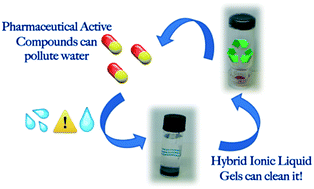Carbon-based ionic liquid gels: alternative adsorbents for pharmaceutically active compounds in wastewater†
Abstract
With the aim of obtaining adsorbent systems to be used for the removal of pharmaceutically active compounds (PhACs) from wastewater, some hybrid ionic liquid gels (HILGs) were obtained from the combination of ionic liquid-based supramolecular gels and carbon materials, like graphite, graphene and graphene oxide (graphene OX). The properties of HILGs were investigated by determining their gel–sol transition temperature and rheological features. They were tested for the removal of PhACs belonging to different pharmaceutical classes, like antibiotics, antidepressants, anti-inflammatory. In particular, the removal of carbamazepine (CBZ), diclofenac sodium salt (DCF), ciprofloxacin (CPX) and nalidixic acid (NXA) alone or in combination was performed. Adsorption tests were carried out with the aim of identifying how different operational parameters, like the time of contact, the PhAC concentration, the volume of treated wastewater and the use under dynamic or static conditions, affect the removal efficiency of the soft materials investigated. Furthermore, the possibility to recycle and restore the sorbent systems for further reuse was also considered. Finally, the most efficient system was also tested in real apparatuses, like a dialysis membrane and columns. HILGs proved to be promising soft materials for addressing the target issue, revealing easy to handle sorbent systems with broad applicability in the field of environmental remediation.



 Please wait while we load your content...
Please wait while we load your content...